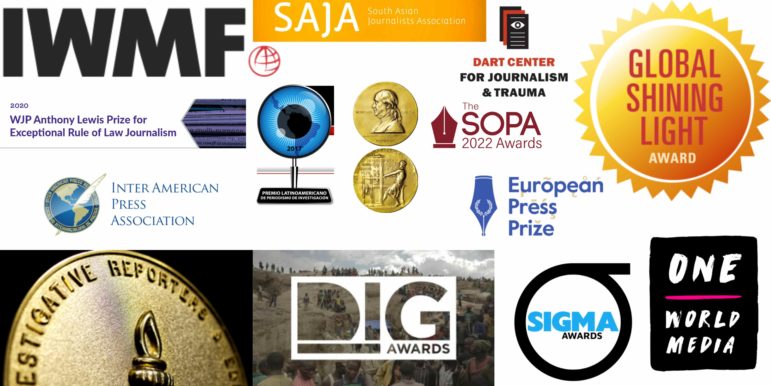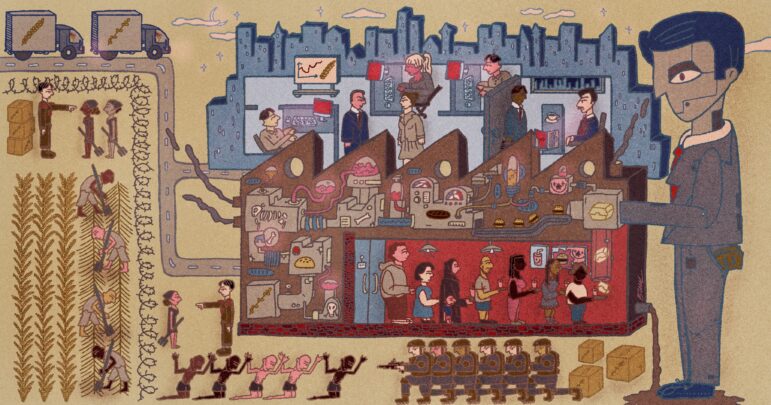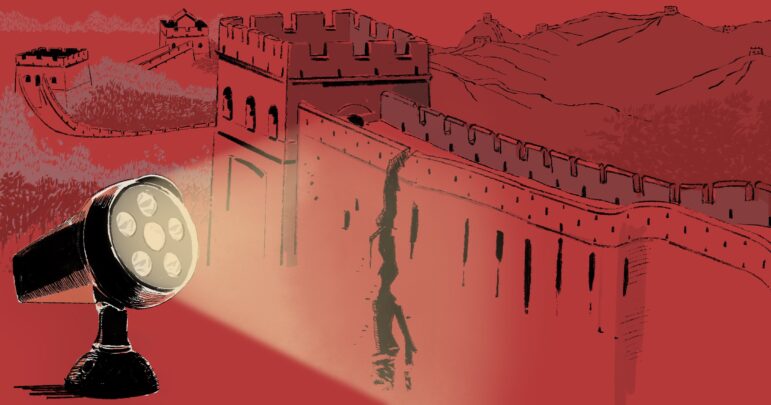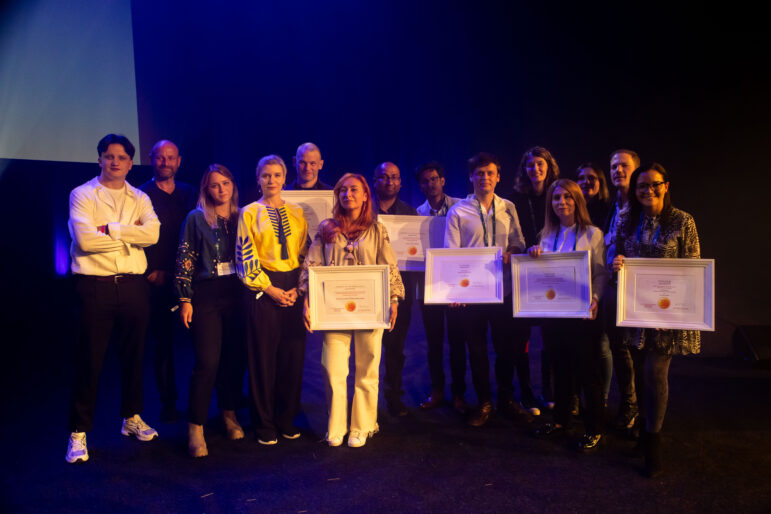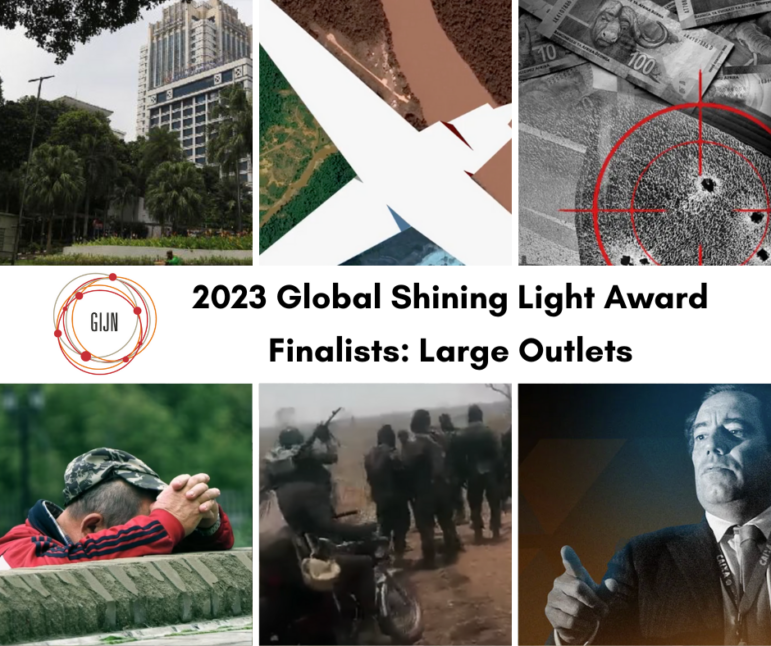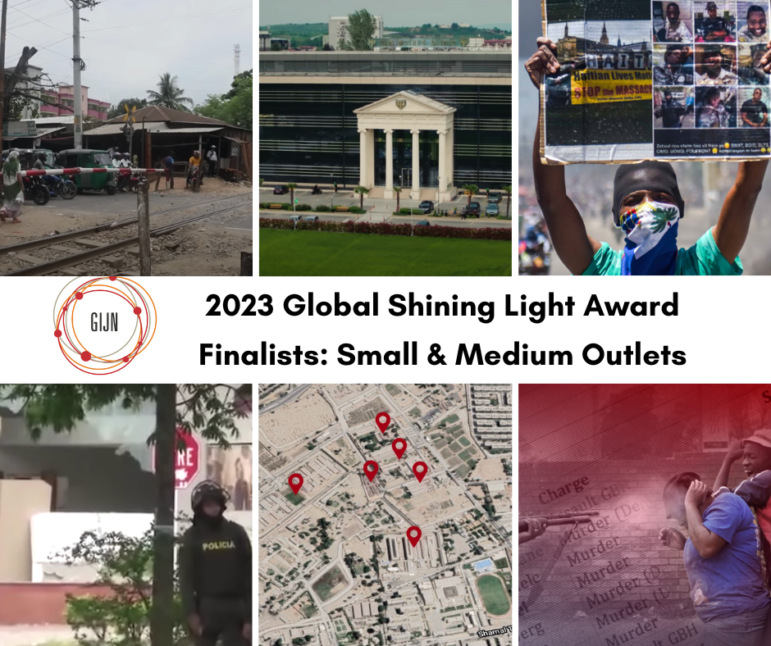

Image: GIJN
2025 Global Shining Light Award Finalists: Large Outlets
Thirteen courageous investigative projects from 11 countries have been selected as finalists for the 2025 Global Shining Light Awards (GSLA) — the prize honoring watchdog journalism in developing or transitioning countries carried out under threat, or in perilous conditions.
The eventual winners will be showcased at an award ceremony at the 14th Global Investigative Journalism Conference (GIJC25) — the world’s premier international gathering of investigative and data journalists — to be held from November 20 to November 24, 2025, in Kuala Lumpur, Malaysia. (Registration for this event — which is expected to attract more than 1,500 investigative journalists, and will feature more than 150 expert panels, workshops, and networking sessions — is open via this link.)
Open for public interest investigative projects published between January 1, 2023 to December 31, 2024 — and reported in challenging circumstances largely in developing nations — the competition attracted 410 entries from 97 countries. Category winners will receive an honorary plaque, a $2,500 cash award, and a trip to GIJC25 in Malaysia to accept the prize.
The five-person GSLA prize committee noted that the 13 finalists in the two categories represent outstanding and courageous examples of the kind of investigative work often necessary to hold bad actors accountable, and shine new light on public interest issues, in the Global South and transitioning nations.
Comprising veteran investigative editors from five continents, the panel chose six stories from small and medium outlets (organizations with staff of 20 or less, including freelancers) and seven from large outlets. (Note: One judge who is a director of a candidate outlet — the Latin American Center for Investigative Journalism (El CLIP) — did not participate in the deliberations when entries from that outlet were considered).
We list the seven finalists for the Large Outlets category below, and GIJN has published the list of the six Small and Medium Outlet finalists in a separate post. The shortlisted entries from large organizations featured powerful exposés on topics such as immigration, organized crime, and human rights violations in war zones.
“The jury noted the remarkable rise in the quality and ambition of the submissions despite the increased risks and challenges faced by investigative journalists in some of the most dangerous places in the world,” said Sheila Coronel, director of the Stabile Center for Investigative Journalism at Columbia University, and convenor of the prize committee.
Please join us in celebrating these outstanding watchdog projects.
2025 Global Shining Light Finalists: Large Outlets Category
Disciples: The Cult of TB Joshua — BBC Africa Eye and OpenDemocracy (Nigeria)

Image: Screenshot, BBC Africa Eye
In an apt description from the entry for this three-part documentary series: “The investigation unearthed crimes of unimaginable scale and severity for a man once regarded as a prospective saint.”
In a three-year investigation into Africa’s most famous evangelical pastor and his Synagogue Church of All Nations — which had amassed more than a billion views online and a devoted following of hundreds of thousands of followers including several foreign presidents — BBC Africa Eye was able to unravel the untainted image and “untouchable” status of Nigeria’s TB Joshua. The team was able to identify victims of numerous forms of sometimes violent abuse in a dozen countries, from the USA and the UK to South Africa and Namibia. But the project was founded on insider testimony: on-the-record accounts of dozens of the pastor’s former “disciples.” In addition to praising the dogged sourcing and compelling storytelling in the series, several members of the GSLA prize committee gave the same summary: “Amazing story!”
Los Vuelos de la Muerte: Líderes Indígenas Asesinados en un Territorio Invadido por 67 Narcopistas (Death Flights: Indigenous Leaders Murdered in a Territory Invaded by 67 Drug Gangs) — Mongabay Latam, Earth Genome
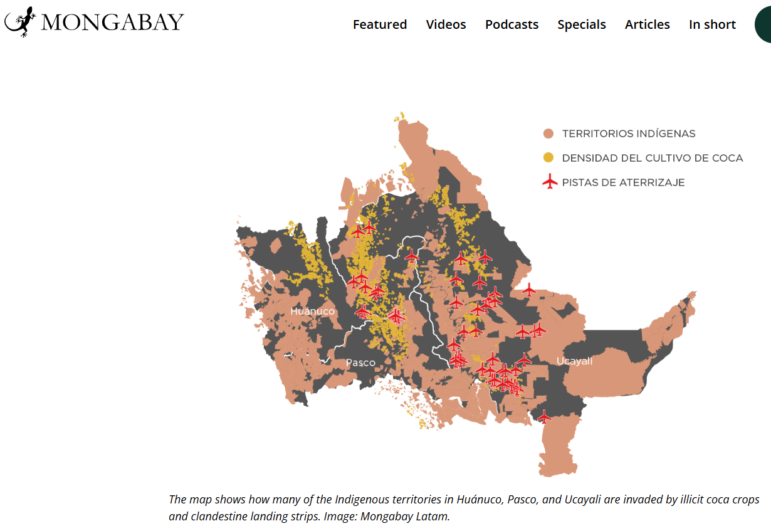
Image: Screenshot, Mongabay Latam
Prior to this project, little was known about how organized crime activities in remote areas of the Amazon affected Indigenous communities there. In a deeply sophisticated and gutsy year-long investigation, Mongabay Latam uncovered a network of drug trafficking airstrips in three Amazonian regions of Peru — as well as the links between these export routes and a campaign of violence and assassinations against Indigenous leaders and communities.
After a data gathering phase featuring information requests, brave on-the-ground reporting, and traditional sources, the team used an AI-powered search tool created by Earth Genome to find deforestation patterns consistent with airstrips already identified with tools such as OpenStreetMap and satellite imagery portals. Focusing on three Peruvian regions — Ucayali, Huánuco, and Pasco — where 15 Indigenous leaders had been killed and where 28 more remain under threat, the team followed a rigorous verification process to identify 67 clandestine airstrips linked to drug trafficking, 30 of which were located within Indigenous territories. As the entry noted: “Seven territories in particular are not only invaded by airstrips, but surrounded by them.”
The project built a database of narco-airstrips that includes location, use, date of opening, distance from roads and rovers, and presence in protected areas.
While the project was rigorous in terms of security precautions for both reporters and sources, serious risks of mafia violence were inherent.
Settlements Above the Law — BBC Eye
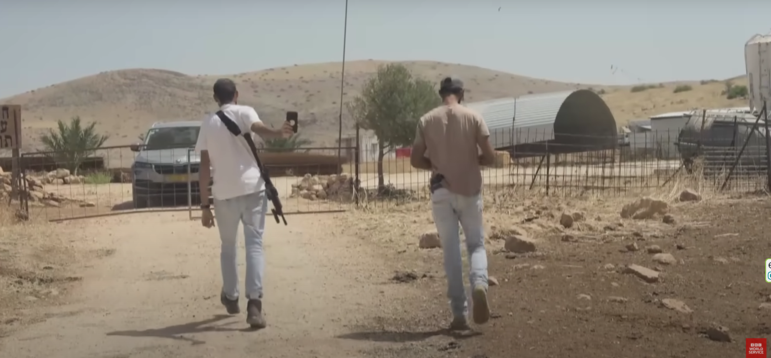
Image: Screenshot, BBC Eye
For more than six months, BBC Eye investigated a new, aggressive form of land theft on the West Bank: “herding outposts” established by extremist Israeli settlers. The project found a rise in land seizure that displaced Palestinian residents in the occupied territory since the Hamas terror attacks on October 7, 2023. The team also showed how two organizations have supported this illegal outpost campaign, and how Israeli authorities have turned a blind eye to violence perpetrated by some new settlers. The team used a combination of satellite mapping and NGO data, as well as numerous interviews and dramatic documentary filming in a hostile and threatening environment.
Describing the project as “a powerful and detailed exposé,” GSLA judges praised the project’s storytelling and data analysis, and its ability to show the mechanics of land seizure in Palestine’s West Bank.
The Faces of Russian Occupation: Mass Identification of Soldiers Who Tortured Civilians and Mined Ukraine — Schemes (Ukraine)
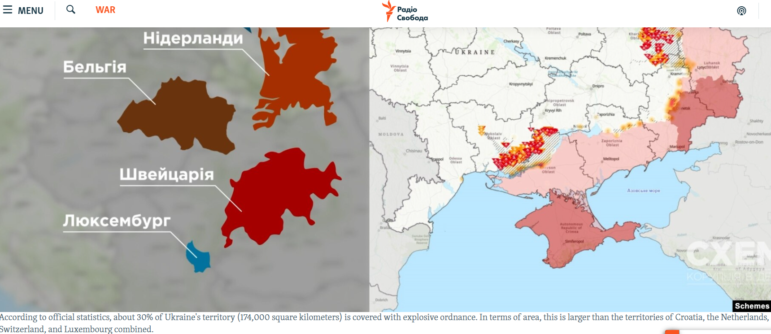
Image: Screenshot, Schemes
The Schemes media outlet obtained a flash drive left behind by a Russian military unit after the city of Balakliya in Ukraine’s Kharkiv region was liberated in late 2022. The information on the hundreds of documents inside would become one of several key sources that allowed the team to not only document war crimes in detail, but also to identify individual perpetrators by name.
Referring to the flash drive data, the Schemes entry stated: “By analyzing thousands of names, the investigative team focused on those who had been awarded for their ‘work with the civilian population’ in Balakliya. After thorough research, they managed to identify several Russian servicemen and classified FSB officers responsible for orchestrating a systematic campaign of intimidation and torture.”
A second investigation in the series revealed Russia’s use of internationally banned anti-personnel mines. Drawing on data from Russian documents — including commendations to engineers who laid the mines, and orders given to Russian sapper regiments — the story set out the varied kinds of munitions types that have killed numerous civilians, and which now make Ukraine the most mined country on Earth.
In addition to the threat of mines themselves, reporters — who arrived immediately after the city’s liberation — were exposed to numerous hazards and psychological pressures, including the lingering threat of Russian reconnaissance units.
The Gaza Project — Collaboration of 50 journalists from 13 media outlets, coordinated by Forbidden Stories
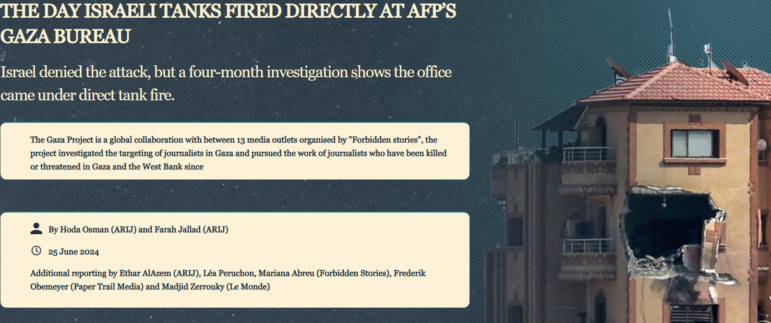
Image: Screenshot, The Gaza Project
The war in Gaza has killed at least 176 journalists and media workers since the Hamas attack on Israel on October 7, 2023, according to the Committee to Protect Journalists, making it the most lethal environment on Earth for reporters.
This collaboration of reporters from 13 outlets set out to investigate whether some of these deaths were the result of deliberate targeting by the Israeli military. With a forensic focus on several individual incidents, the project found damning evidence that directly challenges consistent claims by Israel’s government that their military operations never target the press.
Their case studies include the destruction of Press House and the deaths of journalists including Mohammed Al Jaja and Ahmed Fatima; the tank shelling of a building housing the AFP Gaza Bureau; and an airstrike that killed three Palestinian journalists who believed they were standing at a safe distance from an announced bombing, following a false evacuation order.
The team built detailed timelines from newly unearthed video footage, examined satellite imagery and social media accounts, and interviewed sources including witnesses, weapons experts, and officials. For their “The Day Israeli Tanks Fired Directly at AFP’s Gaza Bureau” story, reporters compared video from multiple angles and used satellite and audio analysis to determine the exact location of Israeli tanks and the trajectory of the four shells they fired.
Tráileres, Trampa Para Migrantes (Cargo Trucks: Trap for Migrants) — Noticias Telemundo and the Latin American Center for Investigative Journalism (El CLIP), in collaboration with ICIJ, Bellingcat, Pie de Página, Chiapas Paralelo (Mexico), En un 2×3 Tamaulipas (Mexico), Plaza Pública (Guatemala), and Contracorriente (Honduras)
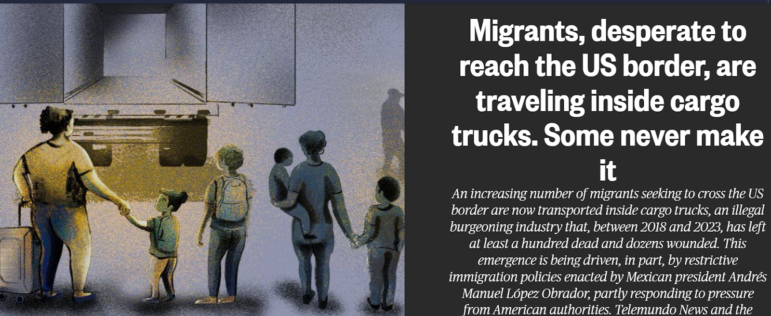
Image: Screenshot, Noticias Telemundo
When this cross-border collaboration was forming, reporters discovered that official data did not exist on road accidents involving migrant smuggling and human trafficking in Mexico. In the end, the team created the first database on this issue, revealing a hidden, lethal safety threat to migrants. The investigation also uncovered new trafficking routes, the increased use of tractor-trailers, the impunity of criminal gangs, coercion of truck drivers, and astonishingly low human trafficking conviction rates in Mexico’s district courts.
Their methodology was grounded in courageous shoe-leather reporting, and included more than 70 records requests, careful data analysis, and testimonies from survivors, drivers, families, and officials. Beyond the general safety risks of investigative work in Mexico, some team members working in the states of Tamaulipas and Chiapas required protection measures in response to specific threats.
Remarks from the prize committee included: “This is dogged reporting, following the story from beginning to conclusion. It uses the tools that made investigative reporting what it is.” Another panel member added: “It told a story that hasn’t been told before. A topic that is very sensitive and relevant.”
Turkey’s EU-Funded Deportation Machine — Lighthouse Reports (Netherlands) Politico (Europe), Der Spiegel (Germany), El País (Spain), Le Monde (France), NRC (Netherlands), Syrian Investigative Reporting for Accountability Journalism Association (Syria), Etiliaat Roz (Afghanistan), and L’Espresso (Italy)
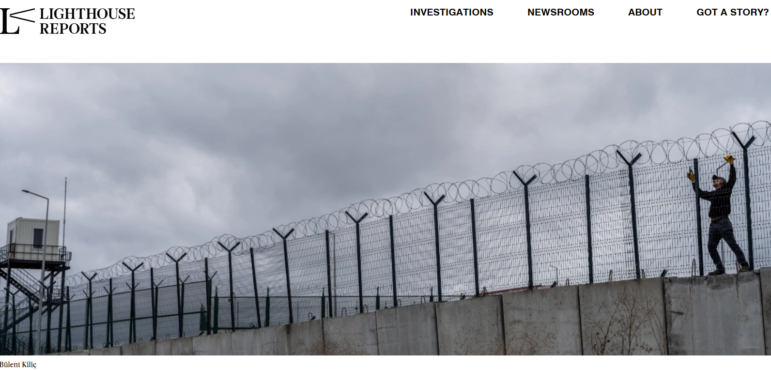
Image: Screenshot, Lighthouse Reports
In a spectacular revelation on an urgent topic, this collaborative cross-border project showed how the European Union has effectively, and secretly, outsourced its migrant deportation system to an inhumane removals network in Turkey. The team found that the EU has channeled hundreds of millions of euros to build and maintain 30 removal centers in Turkey, and to fund systems there that detain and deport Syrian and Afghan migrants and refugees. As the competition entry noted: “The EU deems it unsafe to deport people back to Syria and Afghanistan, yet it makes Turkey a buffer zone to stop them reaching Europe — in return for billions of euros.”
Reporters interviewed more than 100 sources and analyzed hundreds of internal EU documents obtained through records requests, including Turkish officials, removals staff, and former detainees. The piece also revealed abuse and unsanitary conditions within these centers, as well as instances of coercion. And in a chilling example of the risks to reporting this story, Syrian and Afghan journalists based in Turkey found that they themselves were at heightened risk of forced deportation while working on the project. The common word used by GSLA judges to describe this project was “powerful.”
 Rowan Philp is GIJN’s global reporter and impact editor for GIJN. Rowan was formerly chief reporter for South Africa’s Sunday Times. As a foreign correspondent, he has reported on news, politics, corruption, and conflict from more than two dozen countries around the world.
Rowan Philp is GIJN’s global reporter and impact editor for GIJN. Rowan was formerly chief reporter for South Africa’s Sunday Times. As a foreign correspondent, he has reported on news, politics, corruption, and conflict from more than two dozen countries around the world.

